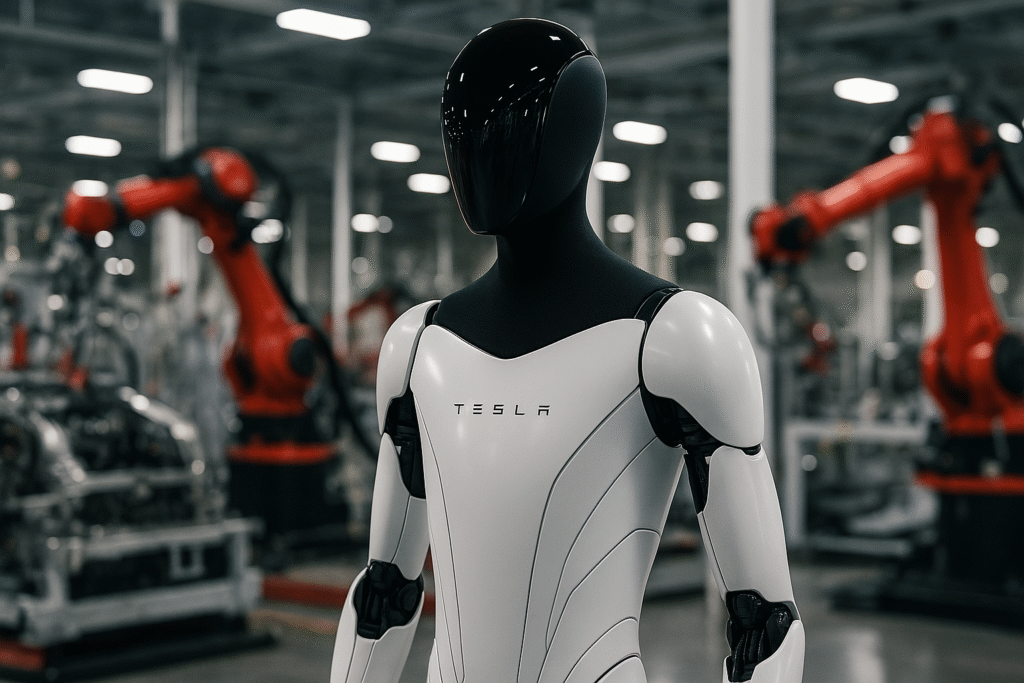In a world teetering on the edge of a technological revolution, Elon Musk once again jolts the imagination of futurists and skeptics alike. Speaking virtually at the 2025 Tesla Owners of Silicon Valley Takeover event, Musk dropped a thunderbolt that resonated far beyond the walls of San Mateo. He claimed Tesla could generate $30 trillion annually from humanoid robot revenue, unleashing what he called an AI supersonic tsunami.
This wasn’t just a fanboy fantasy it marked a bold, albeit aspirational, vision of what Tesla’s Optimus robots might represent for the future of artificial intelligence, labor, and human existence. Tesla’s humanoid robots are no longer a speculative dream they’re a rapidly forming reality that may define the industrial and technological narrative of the next decade.
Tesla’s AI Supersonic Tsunami: What’s Driving the Optimus Vision?
Elon Musk’s proclamation isn’t empty hype. Tesla has quietly been developing Optimus, a general purpose humanoid robot designed to take over repetitive and dangerous tasks. With version 3 of the robot ready for volume production by late 2025, Musk announced that Tesla would manufacture a few hundred units this year scaling up significantly in 2026. Optimus is the right design to go to volume production,” Musk confidently declared during the virtual appearance.
The pivot to humanoid robotics fits perfectly into Tesla’s long term AI roadmap. With their massive investments in Dojo supercomputers and self driving software, Tesla already possesses unparalleled capabilities in neural networks, motion planning, and sensor integration. The robot, according to insiders, is built using many of the same AI algorithms that power Tesla’s Full Self Driving (FSD) systems.
Tesla’s AI in Action From Cars to Robots
Tesla’s existing track record with FSD offers the best real world case study to gauge how its AI capabilities could transfer to humanoid robotics. The FSD beta program now boasts over 1 billion real world miles, and this data has become Tesla’s crown jewel in training next generation AI.
Experts in robotics, like Dr. Cynthia Breazeal from MIT’s Media Lab, note that. Tesla is uniquely positioned because it already has real world datasets at scale. That’s something most humanoid robotics companies are still struggling to obtain.
Tesla’s humanoid robots aren’t starting from scratch. They’re being born into a world of billions of AI trained driving experiences an advantage few, if any, competitors can claim.
Skepticism Meets Optimism
Despite the futuristic glow, not everyone is buying the $30 trillion figure. Dr. Kai-Fu Lee, renowned AI investor and author of AI Superpowers, commented, $30 trillion is an extraordinary figure. To put that in context, the entire U.S. GDP is around $27 trillion. But Musk’s forecasts are usually not about timing they’re about direction.
Still, industry analysts are watching closely. Morgan Stanley, in a recent investor report, estimated the humanoid robot market could reach $150 billion annually by 2035 a far cry from Musk’s vision, but still monumental in scale.
Even that level of adoption would mean Tesla’s humanoid robots could become the backbone of the future industrial workforce performing tasks in construction, manufacturing, logistics, and even healthcare.
Personal Experiences from Early Optimus Trials
Although Optimus is not commercially available yet, limited in-house trials at Tesla’s Gigafactory in Texas offer a glimpse into its potential. According to an anonymous Tesla employee, Optimus is already helping with basic logistics moving parts between assembly stations, organizing tools, and even assisting with basic inspections.
Employees reportedly see the robot as a “relief,” rather than a threat. Tasks that previously led to injuries or repetitive strain are now offloaded to machines. One worker said, It’s not replacing us it’s allowing us to focus on smarter, less painful work. These experiences suggest that Tesla’s humanoid robots could have real-world impact, not just theoretical promise.
Is $30 Trillion Really Possible?
Let’s break down Musk’s number if each robot costs $20,000 (a figure Musk floated in the past), Tesla would need to sell 1.5 billion units per year to reach $30 trillion in annual revenue. That’s over 4 times the number of smartphones sold worldwide annually.
It sounds implausible but not if the economic model changes. Imagine humanoid robots as a service, much like Tesla’s proposed robotaxi fleet. Instead of selling robots, Tesla could lease them to companies, earning consistent revenue for ongoing work and maintenance. This model has already transformed the software industry through SaaS (Software as a Service). Could Tesla pioneer RAAS (Robots as a Service)?
If each robot could earn Tesla $50,000 per year in service contracts, Tesla would need 600 million deployed robots to hit the target. That’s still aggressive but perhaps not impossible by 2040, considering today’s rapid adoption of automation and AI.
The Ethical and Social Implications of Tesla’s AI Army
Mass deployment of humanoid robots also raises ethical and societal questions. Who controls the data these robots collect? Will they replace millions of workers? Could they be weaponized? Elon Musk himself has long warned about the dangers of AI, even while building it.
The duality of his position cautionary and ambitious adds to the complexity. Organizations like the Future of Life Institute stress the need for transparent regulations and international cooperation to avoid dystopian outcomes.
The Supersonic Tsunami Is Here Are We Ready?
Elon Musk’s vision of Tesla’s humanoid robots flooding the market and generating $30 trillion a year is staggering, maybe even fantastical. But dismissing it outright might be as foolish as ignoring the potential of the internet in the 1990s.
Tesla is not just building electric cars. It’s crafting a new kind of worker one that doesn’t eat, sleep, or strike. Whether we embrace it with open arms or cautious legislation, one thing is certain: the age of AI driven humanoid labor is approaching faster than most predicted. And like every Musk prophecy, it’s not a question of if but when.

